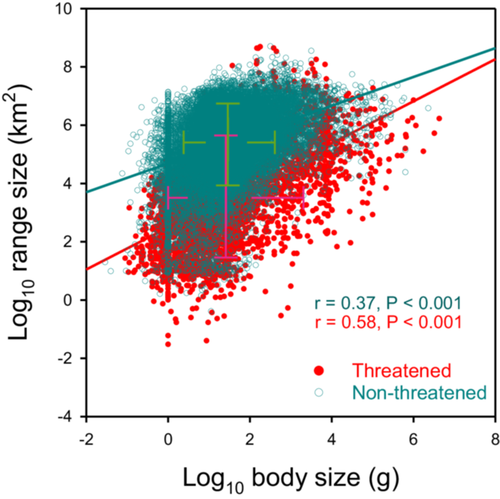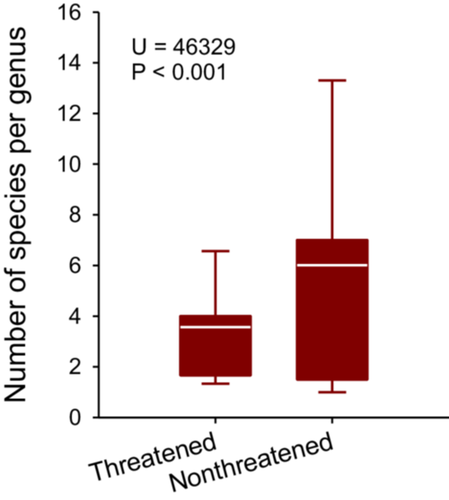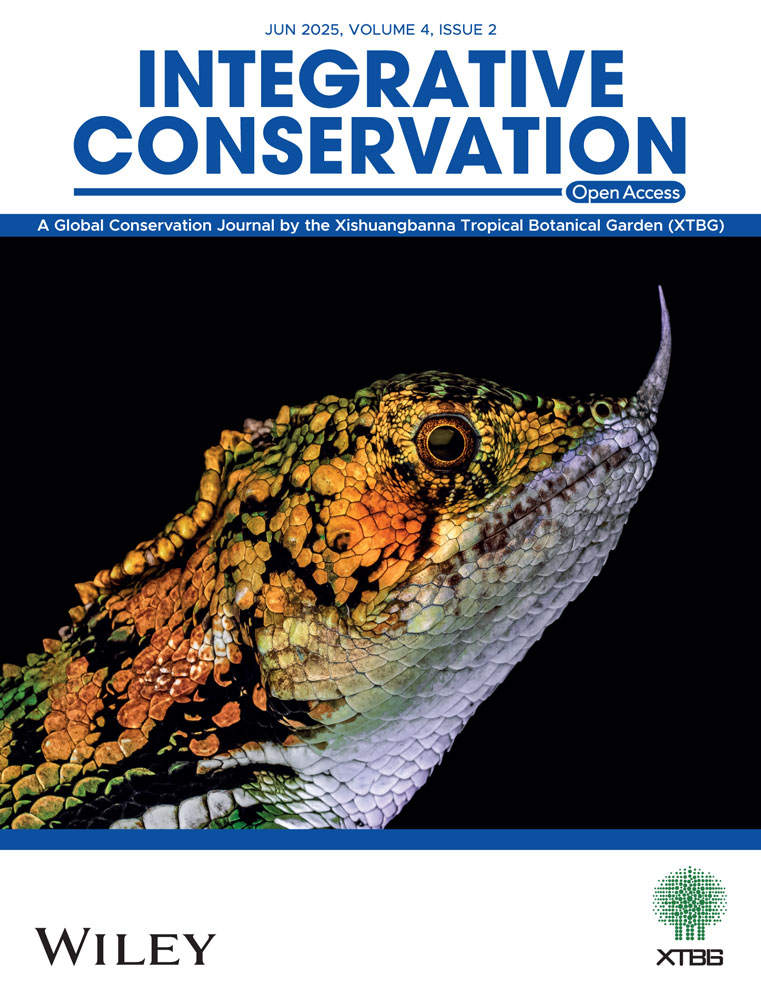Applying Bergmann's Rule to Species Conservation Planning
贝格曼法则在物种保护规划中的应用
Editor-in-Chief & Handling Editor: Ahimsa Campos-Arceiz
ABSTRACT
enBody size is often strongly linked to species abundance and range size. Although Bergman's rule, which relates body size to climate, has been extensively studied, the implications of this rule for conservation remain unclear. Climate warming may reduce the habitat area of some large-bodied species at higher latitudes or altitudes, where they need large ranges to survive, and may also cause some larger-bodied species to shrink, as there is no critical need for them to remain large in order to preserve heat in very cold conditions. Under such circumstances, Bergmann's rule may offer some insights regarding species extinction, as body size is related to other critical traits, such as generation time, especially for species that follow the “rule.” Here, we explore the potential applications of Bergmann's rule in species conservation, using the IUCN's (2022) Red List and species' body size as a reference. Although a greater number of larger birds and mammals (endothermic species) are threatened, a higher proportion of smaller reptiles and amphibians (ectothermic species) face endangerment. Threatened species show stronger body size–range size relationships and are more restricted in monotypic genera. We discuss how Bergmann's rule might be considered in future long-term species conservation planning within the broad context of climate change, human impacts, and species invasions.
摘要
zh体型大小常与物种丰富度和分布区大小密切相关。尽管贝格曼法则已广泛用于体型大小与气候间关系的研究, 但其是否适用于生物保护仍不清晰。气候变暖可能会使一些在高纬度或高海拔地区体型较大物种的栖息地减少, 或使一些体型较大物种体型变小(因为在变暖环境下不需要较大体型保暖)。由于物种体型大小与一些关键特征(如世代和恢复时间)有关, 贝格曼法则可能为物种灭绝提供一些线索, 尤其对于那些遵循该法则的物种。在本研究中, 我们基于IUCN 2022年红色名录和物种体型大小数据分析了贝格曼法则在物种保护中的潜在应用。尽管大型鸟类和哺乳动物(温血型)受威胁物种数更多, 但易危物种中小型两栖爬行动物(冷血型)占比更高。受威胁物种体型大小与分布区大小间相关性较强, 且在单型属中更强。本文进一步讨论了在气候变化、人类影响和物种入侵等影响下, 贝格曼法则如何应用于长期的物种保护规划中。
简明语言摘要
zh贝格曼法则已广泛应用于各类生物, 但其对生物保护规划的可能影响很少被探究。本文基于IUCN 红色名录, 分析讨论了该法对当前物种灭绝和气候变化背景下生物保护的影响。贝格曼法则可以应用到气候变化(如变暖)、人类影响(包括人类辅助迁移)、物种入侵、系统发育和、跨营养级的物种相互作用等生物多样性科学研究与保护中。
Summary
enBergmann's rule has been extensively studied across diverse organism types, but its potential role in conservation planning has received little attention. In this study, we outline and discuss the conservation implications of Bergmann's rule in the context of species extinction and climate change using IUCN's Red List. We explore how Bergmann's rule may inform species conservation in the following contexts: (1) climate change (e.g., warming), (2) human effects (including human-assisted migration), (3) species invasion, (4) phylogenetic relatedness, and (5) inter-trophic species interactions.
-
Practitioner points
- ∘
Body size is confirmed to be an important ecological indicator for assessing extinction risk and guiding species conservation.
- ∘
On IUCN's Red List, threatened species and non-threatened species show distinct patterns in body size, range size, and body size–range size relationships.
- ∘
Bergmann's rule should be considered in future conservation planning, particularly under changing climate conditions.
- ∘
实践者要点
zh
-
体型大小是评估物种灭绝风险和指导物种保护的重要生态指标。
-
受威胁物种和非受威胁物种在体型和分布区大小存在明显差异, 体型-分布区大小间的关系也存在差异。
-
贝格曼法则应成为气候变化背景下物种保护规划的重要考虑因素。
1 Body Size and Bergmann's Rule
Body size is one of the most important life history traits, indicating a species' resource and space requirements, competitive ability, lifespan, generation time, and fertility, among others (Peters 1986; White et al. 2007; Brown 1995). As such, body size may determine how animals share or divide food and other limited resources within and among species (Brown 1995). For example, larger body size may be associated with larger ranges but sometimes lower overall abundance or density due to possible size–number trade-offs (Blackburn and Gaston 1996; Davidson et al. 2009). Larger body size also indicates longer generation time (Supporting Information S1: Figure S1) (Etard et al. 2020), which is related to the average lifespan, recovery time, and population growth rate after experiencing catastrophes or major disturbances—factors that ultimately affect the extinction rate (Hutchings et al. 2012; Davidson et al. 2009).
Among the most well-known macroecological and biogeographical rules related to body size is Bergmann's rule, which states that body size generally decreases with temperature and increases with latitude. Specifically, Bergmann's rule holds that within a broadly distributed taxonomic group of endothermic animals, individuals or populations in colder environments tend to have larger body sizes than those in warmer environments, as greater body mass helps conserve heat by reducing the surface area-to-volume ratio, whereas smaller body sizes in warmer climates facilitate heat dissipation (Bergmann 1848). The rule was initially developed for individual species or closely related taxa but has since been applied to broader taxonomic groups, albeit with inconclusive support in some (e.g., Meiri and Dayan 2003). According to this rule, warmer regions support both large and many small-bodied species (i.e., smaller-bodied species tend to prefer warmer climates), whereas colder regions support a proportionally higher number of large-bodied species.
Previous studies have also investigated the indirect links between body size and species diversity and discussed the associated ecological and evolutionary consequences (Bonner 2007; Peters 1986; Pimm et al. 2014). However, the relationships among body size, range size, and abundance are often complex and show considerable residual variation (Peters and Wassenberg 1983; Blackburn and Gaston 1996). Notably, human activities—such as hunting—and conservation actions—such as human-assisted migration and species introductions—may have significantly altered natural patterns of body size and its relationship with other ecological variables (Campos-Arceiz et al. 2022).
As body size has increasingly been linked to population size, range size, and consequently, extinction rate, Bergmann's rule has significant implications for conservation because it links body size to climate (temperature) and climate change. As outlined in detail below, body size is often associated with a range of species traits and community-level variables such as abundance (population size), range size, and predator–prey interactions—but especially the extinction rate. Following the link between climate and body size described by the rule, warmer regions tend to support both large and many small-bodied species (i.e., smaller-bodied species tend to prefer warmer climates), whereas colder regions support proportionally more large-bodied species. Global warming is thus likely to alter the body size of most vertebrate species (e.g., reduced size with climate warming).
Due to human disturbances and related global climate change, an increasing number of studies have examined links between body size and extinction risk (Chen et al. 2019; Gaston and Blackburn 1996; Cardillo and Bromham 2001; Johst and Brandl 1997). However, most have not specifically addressed the role of Bergmann's rule (i.e., temperature-regulated body size variation) in species conservation. Yet, in the context of global warming, Bergmann's rule is particularly relevant for understanding variations in body size and size-related extinction risk—and thus for informing conservation planning. Given the ongoing loss of biodiversity, we outline below the potential implications of Bergmann's rule for species extinction and conservation, particularly under climate change, using data from the IUCN Red List (2022).
Here, we assess the potential relevance of Bergmann's rule in species conservation planning by analyzing the IUCN (2022) Red List. We constructed a database based on the Red List that includes information on body size and generation time for 25,248 global terrestrial vertebrate (tetrapod) species: birds (8251 species), mammals (4661), reptiles (6918), and amphibians (5418). We classified these species as either threatened species (Critically Endangered–CR, Endangered–EN, and Vulnerable–VU) or non-threatened species (Near Threatened–NT and Least Concern–LC). We then examined whether these species show any body size patterns or biases using the Mann–Whitney rank sum test (comparing threatened vs. non-threatened species) and linear regression (body size vs. generation time). Finally, we use these findings to discuss how Bergmann's rule might inform future long-term species conservation planning, especially in the broader context of climate change, human impacts, and species invasions.
2 Conservation Implications Under Climate Change
- 1.
Bergmann's rule suggests that climate warming may lead to multiple consequences, such as (1) shrinking body size, (2) an increase in small-bodied species due to the extinction or population reduction of larger coexisting species or predators, and (3) a greater dominance of small-bodied species in local communities (Tan et al. 2021).
- 2.
Climate and human activities may jointly influence the relevance and application of Bergmann's rule in conservation (Søren Faurby and Miguel 2016). On the IUCN (2022) Red List, threatened vertebrate species (i.e., Critically Endangered–CR, Endangered–EN, and Vulnerable–VU) are generally smaller in body size than non-threatened species (i.e., Near Threatened–NE and Least Concern–LC) (Supporting Information S1: Figures S2 and S3). However, in terms of proportions, a greater number of species with either very small or very large body sizes are threatened or at high risk of extinction (Supporting Information S1: Figure S3). More importantly, when each of the four classes of terrestrial vertebrates is analyzed separately, larger-bodied species are more likely to be threatened than smaller-bodied species among endothermic taxa (birds and mammals). In contrast, ectothermic species (reptiles and amphibians) show the opposite pattern (Figure 1). Overall, smaller-bodied species usually have smaller ranges and are mostly distributed in warmer or tropical regions. Body size and range size are considerably more variable among threatened species than among non-threatened species, especially for birds and mammals (Figure 2). The body size–range size relationship also indicates that the changes in body size and range size are more tightly coupled for threatened than for non-threatened species (Figure 2). Approximately 41% of all threatened terrestrial vertebrate species worldwide are amphibians, which have a small mean body size, followed by mammals (21%), with the largest mean body size (Supporting Information S1: Figure S4; see also Ripple et al. 2017). The extinctions of very large-bodied species (mostly mammals) in the recent past have been closely associated with increasing human activities (e.g., overkill and land use) (Munstermann et al. 2022; Ripple et al. 2019).
- 3.
Following Bergmann's rule, global warming may cause some species, especially large-bodied species, to become smaller (Frӧhlich et al. 2023). Although there is a generally positive correlation between body size and range size, there are many exceptions, and the strength of this correlation varies among the four classes of terrestrial vertebrates. Large-bodied species with smaller ranges are more vulnerable to extinction, as they require more space to survive and reproduce (Brown and Maurer 1989; Shuai et al. 2021; Chen et al. 2019; Gaston and Blackburn 1996). As many large-bodied species occur at higher latitudes and altitudes (i.e., Bergmann's rule) (Gutiérrez-Pinto et al. 2014), a warming climate is expected to further reduce their range sizes. If an organism's body size can adapt quickly enough to climate warming (Herrera et al. 2022; Millien et al. 2006), latitude may become a useful predictor for assessing the applicability of Bergmann's rule, especially if warming is more pronounced at higher latitudes (Pörtner et al. 2022; Liu et al. 2023; He et al. 2023). Although efforts continue to identify the species or species groups at all taxonomic levels (superclass, class, order, family, genus) that follow Bergmann's rule, the rule may still offer useful insights into how the body size structure of regional assemblages or species groups (Figure 1) and species' distribution ranges might shift under changing climates.
- 4.
The application of Bergmann's rule in conservation should also consider phylogenetics and species age, as there is a clear phylogenetic signal in both body size and threat status (Ripple et al. 2017; Shuai et al. 2021). Most endangered species belong to monotypic genera or genera with relatively few species (Mann–Whitney U = 46329, p < 0.001; Figure 3), which may reflect a degree of phylogenetic uniqueness. In addition, threatened species with smaller ranges tend to be older than the non-threatened species (Mann–Whitney U = 34464507.00, p = 0.002; based on species age data presented in Guo et al. 2024b), possibly due to progressive range contraction over time. Thus, whether a species is—or is likely to become—threatened may, to some degree, be predicted based on information from closely related taxa. However, whether phylogeny is incorporated into analyses of the body size−temperature (or latitude) relationship (Guo et al. 2024) and how this is addressed will help determine how Bergmann's rule should be applied to species conservation within certain taxonomic groups.
- 5.
Changes in body size structure and distribution are closely linked to intra- and inter-trophic species interactions, such as competition and predator–prey interactions, through dynamic top-down and bottom-up forces or cascading ecological effects (Jochum et al. 2012; Ripple and Van Valkenburgh 2010). For example, increased primary productivity in certain habitats due to climate change could cause changes in both the behavior and body size of predators at higher trophic levels (Zhong et al. 2017). Species invasions and poleward range shifts of both native and introduced species lead to novel species assemblages (native plus exotic) and alterations in body size structure and distribution across regions worldwide (Treasure and Chown 2014). This is particularly true when more large-bodied species may shift toward higher latitudes or altitudes in response to climate warming (Treasure and Chown 2014). It remains uncertain whether these new latitudinal body size patterns will continue to follow Bergmann's rule once all (native and exotic) species are considered.
- 6.
Species invasions and human-assisted migration could greatly alter body size and range size distributions at both regional and global scales (Treasure and Chown 2014). In particular, if human influence on animal body size varies across latitudes and regions over time, the relationship between temperature and body size—and thus the applicability of Bergmann's rule—may also change (Smith et al. 2019; Teplitsky et al. 2008; Ripple et al. 2017). As body size and range size are closely linked to extinction rate, human activities have profound implications for area-based conservation efforts (Guo et al. 2024a; Bonner 2007; Gaston and Blackburn 1996).



3 Challenges and Outlook
3.1 Assessing Bergmann's Rule for Species With Very Small Ranges or Populations
Species with very small populations and limited to only a few localities are among the most threatened (Ren et al. 2012). However, it is often difficult to test whether small-ranged species follow Bergmann's rule due to the narrow temperature gradient within their ranges (Guo et al. 2023). Even when temperature regulation of body size may still be operating (e.g., Bergmann's rule), if species do not appear to follow the rule, it is essential to identify other factors and changes that may play more dominant roles (He et al. 2023). For example, some animals can cope with environmental change by adopting behavioral adaptions (Beever et al. 2017). Some birds may show marked changes in other traits—such as bill or beak size—as complementary adjustments or trade-offs in response to muted changes in body size (e.g., Baldwin et al. 2023; Frӧhlich et al. 2023). Quantifying the role and the relative contributions of such alternative factors to species' body size variation, whenever possible, would be extremely valuable.
3.2 Mismatch Between Predictions From Bergmann's Rule and the IUCN (2022) Red List
Bergmann's rule offers some clues regarding species extinctions based on body size and climate change. According to the rule, climate warming should favor species with smaller body sizes, whereas larger-bodied species are predicted to face greater extinction risk (Davidson et al. 2009). However, the proportion of species listed as threatened on the IUCN Red List shows a bimodal distribution (Supporting Information S1: Figure S3); that is, a higher-than-expected proportion of small- and large-bodied species appear on the list. Ripple et al. (2017) provided several detailed explanations for this pattern. Large animals may have experienced more intense pressure from human hunting and have consequently attracted more conservation attention. In contrast, many small-bodied species may also face a high extinction risk due to their limited ranges and heightened sensitivity to environmental changes such as land use and pollution.
For all these reasons, the species on the IUCN Red List do not entirely follow the logic behind Bergmann's rule, as the list largely reflects the species most closely associated with human activity—especially hunting (e.g., for gaming, food, medicine, and other commercial use) of larger animals (Ripple et al. 2017). Additionally, climate warming can lead to two interlinked consequences (Hinderer et al. 2024). First, warming can greatly shrink the habitats (area) of some large-bodied species at higher latitudes or altitudes that usually require large ranges to survive (e.g., polar bears). Second, as stated above, climate warming could also reduce the body size of some larger-bodied species, as there is no longer a critical need for them to be large to preserve heat in very cold conditions.
In sum, Bergmann's rule continues to be tested across species in different taxonomic groups and at different taxonomic levels. It is now clear that the rule has strong implications, especially for the species or species groups that follow it. For example, endothermic (birds and mammals) and ectothermic (reptiles and amphibians) species show opposite body-size structures between the threatened and non-threatened categories. With ongoing climate and land use change, future studies should examine how climate change may drive range shifts in species of different sizes (e.g., poleward), thus affecting the applicability of Bergmann's rule. In basic research, it is critically important to examine how long it may take for certain species to vary in their body size under climate warming. In practice, however, future efforts should jointly consider the applications of Bergmann's rule alongside the effects of climate and human activities in conservation planning.
Author Contributions
Qinfeng Guo: conceptualization, investigation, writing – original draft, methodology, validation, visualization, writing – review and editing, formal analysis, project administration. Hong Qian: investigation, validation, writing – review and editing, data curation. Jian Zhang: investigation, funding acquisition, methodology, validation, writing – review and editing, data curation. Deli Wang: conceptualization, investigation, validation, writing – review and editing. William J. Ripple: writing – review and editing, validation, methodology, investigation.
Acknowledgments
We thank Min Guan, who helped with the compilation of the data on threatened species categories on the IUCN Red List, and many individuals for stimulating discussion on the related topic and constructive comments on an earlier version of the manuscript. Any use of trade, firm, or product names is for descriptive purposes only and does not imply endorsement by the U.S. Government. J.Z. was supported by the National Natural Science Foundation of China (32071538 and 32030068) and the Innovation Program of Shanghai Municipal Education Commission (2023ZKZD36).
Conflicts of Interest
The authors declare no conflicts of interest.
Open Research
Data Availability Statement
The authors have nothing to report.




